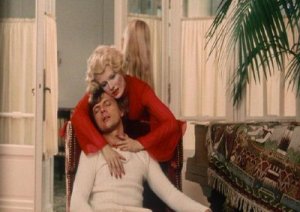The past decade of the 2000s — or the Naughts, if you prefer — were an especially good one for the genre of horror. On television, we were treated to blood-soaked series like Dexter and True Blood, and in the movie theatres, the vampires and zombies ran amok. As is customary this time of year, I like to compile a film-geek list relating to horror. Halloween shall soon be upon us, my deadlings. Let’s revel in the macabre and spooky.
Below are my picks for the past decade’s best offerings in cinematic horror.

Shauna Macdonald in “The Descent,” a horror film by Neil Marshall set in the Appalachian Mountains.
1. The Descent (2005). Directed by Neil Marshall. An exceptionally attractive team of female ‘extreme’ spelunkers are coerced by one of their members to venture into a series of previously unexplored caves. So begins the ill-fated journey of The Descent, one that starts with squirm-inducing claustrophobia and eventually leads to the discovery of something much, much more sinister — and deadly.
2. Låt den rätte komma in (2008). English title: Let the Right One In. Director: Tomas Alfredson. Have not seen the recent English-language remake of this stellar coming-of-age vampire story and, quite frankly, I don’t feel the need. This one got it right. From its very first frame, you can feel the tangible ache of loneliness in the main characters, as well as the relentless cold of the Swedish winter.
3. [REC] (2007), Directors: Jaume Balagueró and Paco Plaza. The first two-thirds of this film were somewhat underwhelming for me. Sure, it was a serviceable, well-crafted ‘documentary’-style zombie film, but I’d seen many of its kind before. And then, the main characters unlock the door to that mysterious, (supposedly) uninhabited penthouse apartment. At that moment, this film transformed from a decent zombie-flick into something almost sublime.

The main character Alison is harassed by a vengeful (and apparently indestructible) Gypsy woman in Raimi's 'Drag Me To Hell.' Someone call the Roma People's Deflamation League.
4. Drag Me To Hell (2009). Director: Sam Raimi. A thoroughly enjoyable, gross, hilarious and, at times, truly scary film from the master of the comedy-horror, Sam Raimi. Watch for the scene with the animatronic goat. Hysterical.
5. Ichi the Killer (2001). Director: Takashi Miike. Just when you think that the saturation point for bloody splatter-gore has been reached, along come Japanese directors like Miike to push the limits beyond all previous imaginings. This film, along with Miike’s 1999 offering Audition, is completely unhinged. My major misgiving with Ichi the Killer is its graphic and highly sexualized violence toward women. Misogyny is a regrettably common characteristic in many of this genre’s films — particularly from countries such as Japan. All the same, I would recommend this film to the seasoned horror fan, simply on the basis of its insanity.

The character Kakihara admires the handiwork of Ichi in Miike's 'Ichi the Killer'.
6. À l’intérieur (2007), English title: Inside. Directors: Julien Maury and Alexandre Bustillo. This past decade has witnessed the growth of a strong horror-film industry in France, a country not previously known for films in this genre. Dubbed by some in the media as ‘New French Extremity,’ films such as Maury and Bastillo’s À l’intérieur confront the viewer with images of intense ‘body horror.’ The alone and heavily pregnant Sarah battles with an insane, homicidal intruder wielding impossibly-sharp — and profoundly effective — tailor scissors.
7. Ginger Snaps (2000). Director: John Fawcett. The mythology of the werewolf gets a modern feminist overhaul in this Canadian horror franchise. The hormone-induced lunacy of puberty is cleverly aligned with lycanthropy when the titular Ginger begins menstruation around the same time as she’s bitten by a ‘big dog’ in the forest surrounding her suburban home. It’s hard not to love a film that has as it’s tagline: “She’s got the curse.” Incidentally, the sequel Ginger Snaps 2: Unleashed (2004) was surprisingly good. The third installment, Ginger Snaps Back: The Beginning should be encased in cement, tossed down a mine shaft, and buried for eternity.

One of the feigned 'death scenes' staged by the Fitzgerald sisters in 'Ginger Snaps'. Kids these days.
8. Ju-on (2003). English title The Grudge. Director: Takashi Shimizu. Hands-down, my favourite amongst all of the J-horror films I’ve seen over the past decade. And I’ve seen quite a few. The English-language remake is laughable by comparison. Avoid it and seek out the original Japanese film.
9. El orfanato (2007). English title: The Orphanage. Director: Juan Antonio Bayona. With contemporary French horror-film directors so successfully flooding the cinema with blood and viscera, it’s a rare treat to view a relatively subtle, classic ghost story like Bayona’s El orfanato. One of the very few horror films at which I openly wept. The ending is heartbreaking, and wonderful.

Autocannibalism + feminism combine in Marina de Van's disturbing 'In My Skin.'
10. Dans ma peau (2002), English title: In My Skin. Directed, written by and starring Marina de Van, this is a strange, atmospheric and generally overlooked gem of New French Extremity. The main character Esther develops an erotically-charged, cannibalistic fixation with her own body after being disfigured in a freak accident. Ponderously slow in parts, it does offer a unique and interesting premise.
Honourable Mentions:
1. Pontypool (2009). Director: Bruce McDonald.
2. Død snø (2009). English title “Dead Snow.”
3. Bakjwi (2009). English title “Thirst”. Director: Park Chan-Wook
4. Grindhouse Presents: Planet Terror (2007), Dir. Robert Rodriguez.
5. 28 Days Later (2002), Dir. Danny Boyle.
43.652500
-79.381667





























